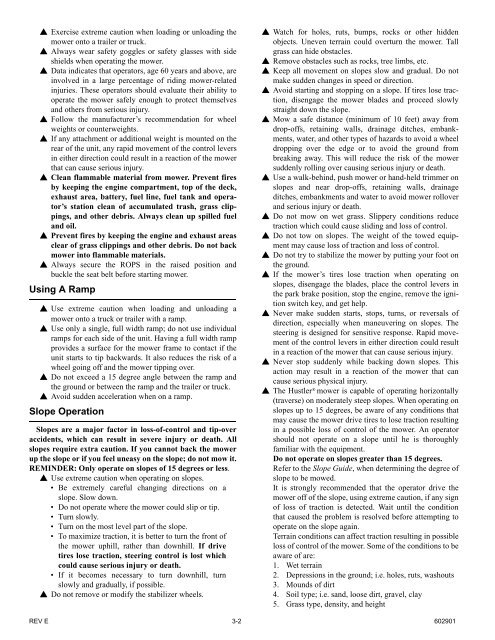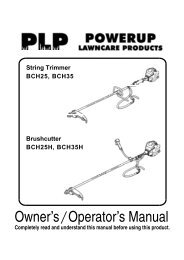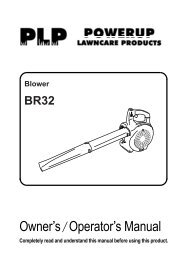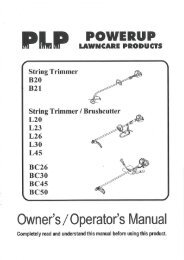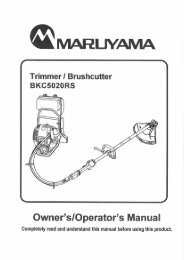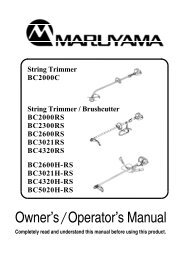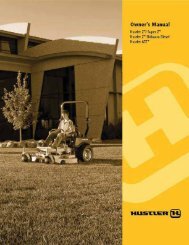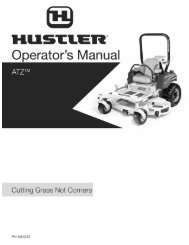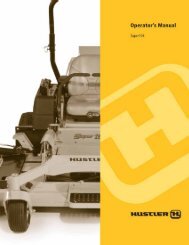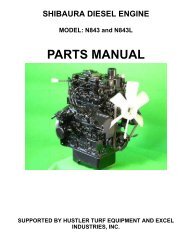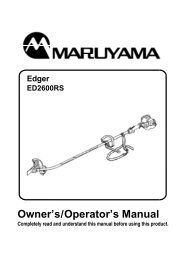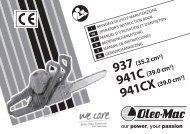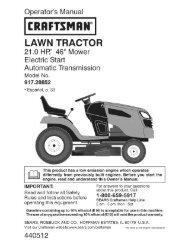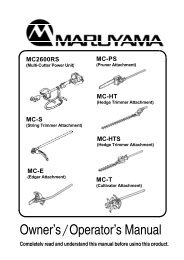Download the Fastrack Super Duty Owner's Manual 48/54/60
Download the Fastrack Super Duty Owner's Manual 48/54/60
Download the Fastrack Super Duty Owner's Manual 48/54/60
You also want an ePaper? Increase the reach of your titles
YUMPU automatically turns print PDFs into web optimized ePapers that Google loves.
Exercise extreme caution when loading or unloading <strong>the</strong><br />
mower onto a trailer or truck.<br />
Always wear safety goggles or safety glasses with side<br />
shields when operating <strong>the</strong> mower.<br />
Data indicates that operators, age <strong>60</strong> years and above, are<br />
involved in a large percentage of riding mower-related<br />
injuries. These operators should evaluate <strong>the</strong>ir ability to<br />
operate <strong>the</strong> mower safely enough to protect <strong>the</strong>mselves<br />
and o<strong>the</strong>rs from serious injury.<br />
Follow <strong>the</strong> manufacturer’s recommendation for wheel<br />
weights or counterweights.<br />
If any attachment or additional weight is mounted on <strong>the</strong><br />
rear of <strong>the</strong> unit, any rapid movement of <strong>the</strong> control levers<br />
in ei<strong>the</strong>r direction could result in a reaction of <strong>the</strong> mower<br />
that can cause serious injury.<br />
Clean flammable material from mower. Prevent fires<br />
by keeping <strong>the</strong> engine compartment, top of <strong>the</strong> deck,<br />
exhaust area, battery, fuel line, fuel tank and operator’s<br />
station clean of accumulated trash, grass clippings,<br />
and o<strong>the</strong>r debris. Always clean up spilled fuel<br />
and oil.<br />
Prevent fires by keeping <strong>the</strong> engine and exhaust areas<br />
clear of grass clippings and o<strong>the</strong>r debris. Do not back<br />
mower into flammable materials.<br />
Always secure <strong>the</strong> ROPS in <strong>the</strong> raised position and<br />
buckle <strong>the</strong> seat belt before starting mower.<br />
Using A Ramp<br />
Use extreme caution when loading and unloading a<br />
mower onto a truck or trailer with a ramp.<br />
Use only a single, full width ramp; do not use individual<br />
ramps for each side of <strong>the</strong> unit. Having a full width ramp<br />
provides a surface for <strong>the</strong> mower frame to contact if <strong>the</strong><br />
unit starts to tip backwards. It also reduces <strong>the</strong> risk of a<br />
wheel going off and <strong>the</strong> mower tipping over.<br />
Do not exceed a 15 degree angle between <strong>the</strong> ramp and<br />
<strong>the</strong> ground or between <strong>the</strong> ramp and <strong>the</strong> trailer or truck.<br />
Avoid sudden acceleration when on a ramp.<br />
Slope Operation<br />
Slopes are a major factor in loss-of-control and tip-over<br />
accidents, which can result in severe injury or death. All<br />
slopes require extra caution. If you cannot back <strong>the</strong> mower<br />
up <strong>the</strong> slope or if you feel uneasy on <strong>the</strong> slope; do not mow it.<br />
REMINDER: Only operate on slopes of 15 degrees or less.<br />
Use extreme caution when operating on slopes.<br />
• Be extremely careful changing directions on a<br />
slope. Slow down.<br />
• Do not operate where <strong>the</strong> mower could slip or tip.<br />
• Turn slowly.<br />
• Turn on <strong>the</strong> most level part of <strong>the</strong> slope.<br />
• To maximize traction, it is better to turn <strong>the</strong> front of<br />
<strong>the</strong> mower uphill, ra<strong>the</strong>r than downhill. If drive<br />
tires lose traction, steering control is lost which<br />
could cause serious injury or death.<br />
• If it becomes necessary to turn downhill, turn<br />
slowly and gradually, if possible.<br />
Do not remove or modify <strong>the</strong> stabilizer wheels.<br />
Watch for holes, ruts, bumps, rocks or o<strong>the</strong>r hidden<br />
objects. Uneven terrain could overturn <strong>the</strong> mower. Tall<br />
grass can hide obstacles.<br />
Remove obstacles such as rocks, tree limbs, etc.<br />
Keep all movement on slopes slow and gradual. Do not<br />
make sudden changes in speed or direction.<br />
Avoid starting and stopping on a slope. If tires lose traction,<br />
disengage <strong>the</strong> mower blades and proceed slowly<br />
straight down <strong>the</strong> slope.<br />
Mow a safe distance (minimum of 10 feet) away from<br />
drop-offs, retaining walls, drainage ditches, embankments,<br />
water, and o<strong>the</strong>r types of hazards to avoid a wheel<br />
dropping over <strong>the</strong> edge or to avoid <strong>the</strong> ground from<br />
breaking away. This will reduce <strong>the</strong> risk of <strong>the</strong> mower<br />
suddenly rolling over causing serious injury or death.<br />
Use a walk-behind, push mower or hand-held trimmer on<br />
slopes and near drop-offs, retaining walls, drainage<br />
ditches, embankments and water to avoid mower rollover<br />
and serious injury or death.<br />
Do not mow on wet grass. Slippery conditions reduce<br />
traction which could cause sliding and loss of control.<br />
Do not tow on slopes. The weight of <strong>the</strong> towed equipment<br />
may cause loss of traction and loss of control.<br />
Do not try to stabilize <strong>the</strong> mower by putting your foot on<br />
<strong>the</strong> ground.<br />
If <strong>the</strong> mower’s tires lose traction when operating on<br />
slopes, disengage <strong>the</strong> blades, place <strong>the</strong> control levers in<br />
<strong>the</strong> park brake position, stop <strong>the</strong> engine, remove <strong>the</strong> ignition<br />
switch key, and get help.<br />
Never make sudden starts, stops, turns, or reversals of<br />
direction, especially when maneuvering on slopes. The<br />
steering is designed for sensitive response. Rapid movement<br />
of <strong>the</strong> control levers in ei<strong>the</strong>r direction could result<br />
in a reaction of <strong>the</strong> mower that can cause serious injury.<br />
Never stop suddenly while backing down slopes. This<br />
action may result in a reaction of <strong>the</strong> mower that can<br />
cause serious physical injury.<br />
The Hustler ® mower is capable of operating horizontally<br />
(traverse) on moderately steep slopes. When operating on<br />
slopes up to 15 degrees, be aware of any conditions that<br />
may cause <strong>the</strong> mower drive tires to lose traction resulting<br />
in a possible loss of control of <strong>the</strong> mower. An operator<br />
should not operate on a slope until he is thoroughly<br />
familiar with <strong>the</strong> equipment.<br />
Do not operate on slopes greater than 15 degrees.<br />
Refer to <strong>the</strong> Slope Guide, when determining <strong>the</strong> degree of<br />
slope to be mowed.<br />
It is strongly recommended that <strong>the</strong> operator drive <strong>the</strong><br />
mower off of <strong>the</strong> slope, using extreme caution, if any sign<br />
of loss of traction is detected. Wait until <strong>the</strong> condition<br />
that caused <strong>the</strong> problem is resolved before attempting to<br />
operate on <strong>the</strong> slope again.<br />
Terrain conditions can affect traction resulting in possible<br />
loss of control of <strong>the</strong> mower. Some of <strong>the</strong> conditions to be<br />
aware of are:<br />
1. Wet terrain<br />
2. Depressions in <strong>the</strong> ground; i.e. holes, ruts, washouts<br />
3. Mounds of dirt<br />
4. Soil type; i.e. sand, loose dirt, gravel, clay<br />
5. Grass type, density, and height<br />
REV E 3-2 <strong>60</strong>2901


